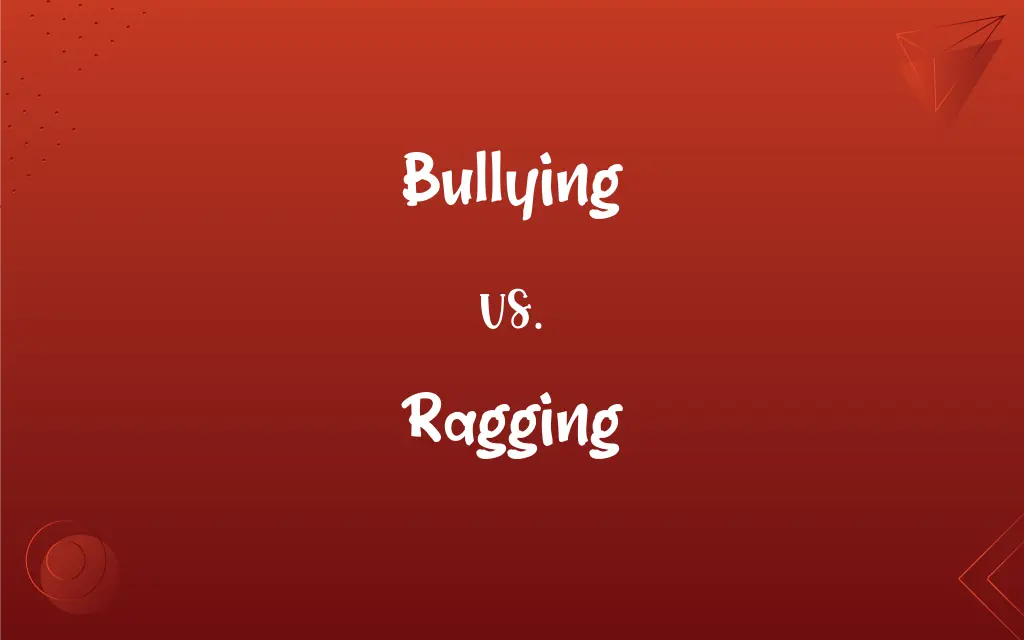Bullying vs. Ragging: What's the Difference?
Edited by Aimie Carlson || By Harlon Moss || Published on February 20, 2024
Bullying is repeated aggressive behavior intending to harm or intimidate; ragging is a form of hazing, often occurring in educational institutions, involving pranks or tasks.

Key Differences
Bullying involves repeated, aggressive behavior intended to hurt or intimidate another person, often where there is a perceived power imbalance. It can occur in various settings, including schools, workplaces, and online (cyberbullying). Bullying tactics can include physical harm, verbal assaults, social exclusion, and spreading rumors. In contrast, Ragging refers specifically to acts of hazing or initiation, particularly in educational institutions, where seniors may subject newcomers to pranks, compulsory tasks, or mock rituals. While sometimes perceived as a form of social interaction, ragging can escalate into abuse or harassment.
The scope of bullying encompasses a wide range of actions, from physical violence to subtle psychological manipulation. It can manifest in direct forms, like physical attacks, or indirect forms, such as gossiping or cyberbullying. The impact of bullying often extends beyond the immediate victim, affecting bystanders and the broader environment. On the other hand, ragging is traditionally associated with college campuses or boarding schools and involves activities aimed at integrating newcomers into a group. However, ragging can become problematic when it involves humiliation, mental or physical abuse, and coercion.
In terms of intervention, bullying often requires comprehensive approaches involving educators, parents, and community members. Anti-bullying policies and programs focus on prevention, education, and addressing incidents effectively. In contrast, ragging has led to specific legal measures in some countries, especially in South Asia, where laws have been enacted to prevent and punish ragging in educational institutions. These measures are often a response to extreme cases where ragging has led to severe psychological trauma or even fatalities.
Bullying is recognized globally as a serious issue that can have long-lasting effects on individuals' mental health, self-esteem, and overall well-being. It is not limited by age, gender, or environment and can affect anyone, though certain groups may be more vulnerable. In comparison, ragging is more culturally specific and often rationalized as a tradition or rite of passage in educational settings. Despite this, there is growing recognition of the potential harms of ragging, leading to increased scrutiny and efforts to change these practices.
The motivations behind bullying can vary, including a desire for power, attention, or control, or as a response to personal issues such as insecurity or trauma. Bullies may target individuals based on perceived differences such as race, religion, sexual orientation, or appearance. Conversely, ragging is often justified as a means of breaking down barriers and fostering camaraderie among students. However, when taken to extremes, it can reflect underlying issues of power dynamics, seniority, and the misuse of authority within educational institutions.
ADVERTISEMENT
Comparison Chart
Definition
Repeated, intentional harm or intimidation
Hazing or initiation in educational settings
Common Settings
Schools, workplaces, online
Colleges, universities, dormitories
Forms
Physical, verbal, social, cyberbullying
Pranks, tasks, mock rituals
Legal and Policy Response
Anti-bullying policies and programs
Specific laws against ragging
Motivations
Power, control, personal issues
Tradition, integration, seniority
ADVERTISEMENT
Bullying and Ragging Definitions
Bullying
Persistent actions that belittle, threaten, or harm.
Cyberbullying has become a significant issue with the rise of social media.
Ragging
Hazing rituals in educational institutions for newcomers.
The university has strict policies against ragging.
Bullying
Harassment that can be verbal, physical, or psychological.
Verbal bullying often involves name-calling and insults.
Ragging
Initiation practices involving pranks or tasks.
Ragging at the college often involved making freshmen perform silly tasks.
Bullying
Behavior that causes fear or distress in the victim.
Many anti-bullying campaigns focus on empowering bystanders to intervene.
Ragging
Activities under the guise of socializing or tradition.
Ragging was often justified as a way to build team spirit.
Bullying
Intentional, repeated aggressive behavior to harm or intimidate.
The school implemented a new program to combat bullying.
Ragging
Acts that can escalate to harassment or abuse.
Severe ragging incidents led to the implementation of anti-ragging laws.
Bullying
Use of power to control or hurt others.
Bullying in the workplace can create a toxic environment.
Ragging
Practices meant to integrate but can marginalize or humiliate.
The college's orientation week is designed to avoid any form of ragging.
Bullying
A person who is habitually cruel or overbearing, especially to smaller, weaker, less popular, or more vulnerable people.
Ragging
To criticize or scold (someone).
FAQs
How is ragging different from bullying?
Ragging specifically refers to hazing or initiation practices in educational settings.
Is ragging legal?
Ragging is illegal in many countries, especially when it involves harassment or harm.
What are the effects of bullying?
Bullying can lead to mental health issues, lowered self-esteem, and physical harm.
What constitutes bullying?
Bullying involves repeated, aggressive behavior intended to harm or intimidate another.
Can ragging be seen as a tradition?
While some view ragging as a tradition or rite of passage, it is increasingly recognized as potentially harmful and abusive.
What is the purpose of anti-ragging laws?
Anti-ragging laws aim to prevent and punish abusive or coercive hazing practices in educational institutions.
What is the role of educational institutions in preventing ragging?
Institutions are responsible for creating safe environments, enforcing anti-ragging policies, and educating students about the harms of ragging.
Are there laws against bullying?
Many regions have policies or laws against bullying, especially in schools and workplaces, to protect individuals and promote safe environments.
Can bullying occur in adults?
Yes, bullying can occur at any age, including in workplaces or online (cyberbullying).
What forms can bullying take?
Bullying can be physical, verbal, social (exclusion), or cyberbullying (online).
How is ragging justified in some cultures?
Ragging is sometimes justified as a means to build camaraderie or integrate newcomers, though this perspective is changing.
Can bullying lead to legal action?
Yes, in severe cases, bullying can lead to legal action, especially if it involves assault or harassment.
Does ragging only occur in colleges?
While most common in colleges, ragging can also occur in other educational settings like boarding schools.
Is bullying a global issue?
Yes, bullying is a recognized issue worldwide, affecting individuals in various social settings.
What are the psychological impacts of ragging?
Ragging can lead to anxiety, depression, and trauma, especially if it involves humiliation or abuse.
Are there specific interventions for bullying?
Interventions include educational programs, counseling, and policies to address and prevent bullying.
How does cyberbullying differ from traditional bullying?
Cyberbullying occurs online or via digital platforms and can involve spreading rumors, harassment, or threats.
How can individuals respond to bullying?
Responses include seeking support from authorities, speaking out, and participating in anti-bullying programs.
Can bullying impact academic performance?
Yes, bullying can negatively impact academic performance and school attendance.
Is there a way to prevent ragging?
Prevention includes strict enforcement of anti-ragging policies, awareness programs, and promoting a culture of respect and inclusivity in educational settings.
About Author
Written by
Harlon MossHarlon is a seasoned quality moderator and accomplished content writer for Difference Wiki. An alumnus of the prestigious University of California, he earned his degree in Computer Science. Leveraging his academic background, Harlon brings a meticulous and informed perspective to his work, ensuring content accuracy and excellence.
Edited by
Aimie CarlsonAimie Carlson, holding a master's degree in English literature, is a fervent English language enthusiast. She lends her writing talents to Difference Wiki, a prominent website that specializes in comparisons, offering readers insightful analyses that both captivate and inform.







































































